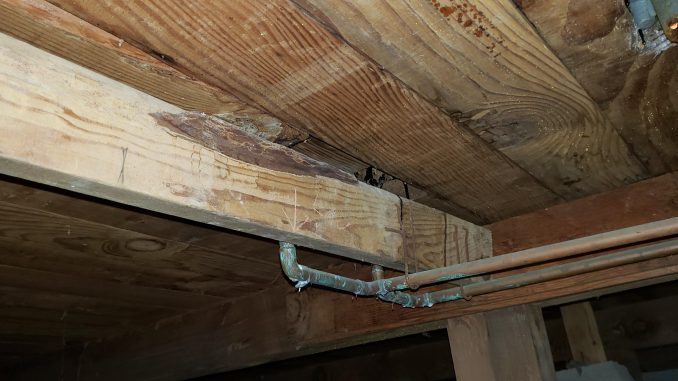
Home inspections often find homes have damage from water leaks. Water damage can be expensive and affect your health, so a good offense is the best defense.
Once water enters your home, it can be difficult to remove. Sometimes water damage is immediately visible, like roof leaks causing ceiling drips. Often water damage builds over time; and the organisms it carries feed on your wood and insulation.
The best home inspectors see examples of water intrusion like:
– Blockages or improperly sealed joints in condensation drain pipes for HVAC systems
– Window shutters (screwed or nailed) penetrating exterior siding
– Doors and window trim
– Butt joints (wood siding or engineered wood siding)
– Mounts, fasteners, and drilled holes due to installation of satellite dishes, cable, and phone lines.
Preventing problems is easy with these 5 maintenance tips to help keep your house dry and foundations strong:
1. Caulking & Sealing. Everywhere something is installed or stuck to the exterior siding of your home, or penetrates the roof, is an opportunity for water damage.
Vents, chimneys, skylight, or other objects (trim,siding, shutters, equipment that is nailed, screwed, or butts up against another object), are opportunities for water intrusion. Sprinklers? Washing the car? Anything that puts water onto the house creates opportunities for water damage.
Each year, before the rainy season, inspect metal flashing for damage, clear out roof debris, and inspect flexible seals (caulking, rubberized seals), for cracks or damage.
Seal around trim pieces and butt joints with paintable silicon caulking. Silicon caulking lasts for decades under harsh weather conditions. Get high quality caulking.
Quality exterior primer and paint are important. As home inspectors, for our own projects, we like Alkyd style paints as opposed latex / enamel paints. Alkyd paints stand up to abuse, and are like a hybrid between oil-based and latex / enamel paints, with resins that dry durable and resistant to wear. Ask your local hardware store.
2. Clean the gutters. To work properly, gutters must be free of leaves, moss, and other debris. Clean your gutters regularly so they don’t fill with water, spill over onto your eaves and fascia, down the sides and onto the foundation. Clean gutters help to carry water safely away from your home.
3. Watch for signs of a leak. Pipes get stressed, joints spring leaks, pipes decay and start dripping. Did you know cast iron drain /waste pipes in all homes 50+ years old are past their service life, and may be leaking water beneath your home?
Mold and termites like moist environments. Identify and repair potential water leaks, pay attention to upticks in your water bill, listen for dripping sounds, and looking under your home at the plumbing. Look for signs of trouble, like dark spots around pipes, edges of your windows, or ceiling stains. A smart water leak sensor can detect hidden leaks and alert you when there’s an issue.
4. Avoid chemical drain cleaners. Most older homes have some form of metal drain pipe system (cash iron, galvanized steel). Strong chemicals can erode pipes and cause leaks. Drain snakes are inexpensive, easy to use effective, and better for the environment.
5. Pipe Insulation. Water expands when it freezes, sometimes bursting pipes. There are ways to avoid bursting pipes. If you leave faucets dripping to give the water a place to go, or insulation of outdoor spigots with a foam cover / shield, be sure to take action before freezing weather hits.
Lastly, check your homeowners insurance. Make sure you know what your policy covers in the event you do have to file a claim.
Questions? Contact our home inspectors.
